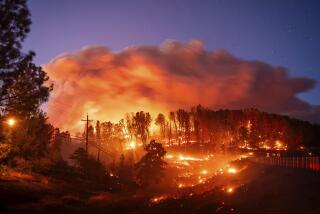In Colo. Blaze Battle, 1st ‘Real Counterpunch’
- Share via
DENVER — The weather finally cooperated with crews battling a 100,000-acre wildfire south of Denver. Pilots attacked the blaze from the air, using borrowed military tanker airplanes, while nearly 1,000 firefighters made a stand on the ground Thursday, backed by long lines of fire engines.
“Things have been pretty quiet today. For the first time, they were able to get on it,” said Pam Devore of the U.S. Forest Service. It was the first day that firefighters were placed on the fire’s north end, which had been burning out of control.
Even as they offered some good news, fire officials told beleaguered evacuees that it could take as long as three months to contain the Hayman fire, the largest in Colorado’s history.
As of Thursday evening, the Hayman fire was 20 miles long and 14 miles wide, spreading north from Lake George about 80 miles southwest of Denver and burning to the city’s southern suburbs. More than 6,000 suburban-town residents had been evacuated, and thousands more remained on alert.
Thursday’s strategy was to encircle the fire with crews digging fire lines and defend homes in the fire’s path. Reinforcements from across the country bolstered the firefighting effort, the most intensive since the fire broke out in the Pike National Forest on Saturday.
“It’s the first day we’ve had a real counterpunch,” said Rep. Scott McInnis (R-Colo.), who toured the burn area with Forest Service head Dale Bosworth.
McInnis said the Hayman fire had been particularly fierce in the forests above 9,000 feet. “It’s like gunpowder up there,” he said.
McInnis said the Federal Emergency Management Agency on Thursday gave Colorado $20 million toward the cost of fighting the seven major fires raging in the state. Altogether, 150,000 acres were burning Thursday.
In Washington, Forest Service officials told Congress that the Colorado fires were costing $3 million a day to fight and warned that the government’s $383-million fund for fighting wildfires would be exhausted by the end of July, when the fire threat in the West usually peaks.
The huge fire south of Denver continues to throw off incredible heat. Meteorologists said the Hayman fire’s 15,000-foot smoke plume was spawning nightly thunderstorms in neighboring states and had triggered two tornadoes that spun through Kansas.
The dense smoke has often grounded tankers and helicopters. Even when water-carrying helicopters have been able to dump their loads of thousands of gallons of water on the fire, the heat in the upper atmosphere has been so intense that most of the water evaporated above the treetops.
Officials warned that one day of reasonable conditions would not make much of a dent in the Hayman fire.
Unpredictable winds in part caused on-again, off-again evacuation orders, frustrating thousands of residents. Many have chosen to clear out.
The fire, with its sudden directional changes, trapped and killed about 30 head of cattle on the loose from a burned dude ranch.
The fire was 5% contained as of Thursday evening, officials said.
More to Read
Sign up for Essential California
The most important California stories and recommendations in your inbox every morning.
You may occasionally receive promotional content from the Los Angeles Times.











